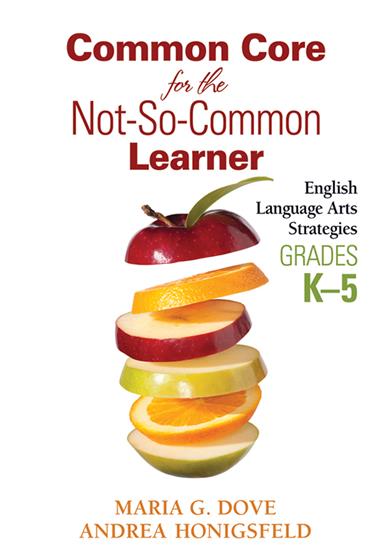
Hands-on, Practical Guidance for Educators
From math,
literacy, equity, multilingual learners, and SEL, to assessment, school counseling,
and education leadership, our books are research-based and authored by experts
on topics most relevant to what educators are facing today.
Common Core for the Not-So-Common Learner, Grades K-5
Help every student, including English Learners, students with disabilities, speakers of nonstandard English, and other struggling learners, meet the Common Core Standards for English Language Arts!
- Grade Level: K-5
- ISBN: 9781452257822
- Published By: Corwin
- Year: 2013
- Page Count: 232
- Publication date: April 12, 2013
Review Copies
Description
The strategies you need to teach common standards to diverse learners
The elementary years are a critical opportunity to help students of all backgrounds meet the demands of the Common Core Standards. In this realistic, thorough book, Maria Dove and Andrea Honigsfeld show how to help every K-5 student, including English Learners, students with disabilities, speakers of nonstandard English, and other struggling learners, meet the Common Core Standards for English Language Arts (ELA).
Educators will find an adaptable approach that ensures all students develop lasting language skills. This resource
- Familiarizes readers with each of the Common Core's 32 ELA anchor standards
- Outlines the specific skills that students need to master each standard
- Presents a wealth of flexible teaching strategies and instructional tools aligned to each anchor standard
- Includes guidance on collaboration and co-teaching for student success
Common Core for the Not-So-Common Learner is the standards-based ELA resource that elementary teachers have been waiting for!
"Each anchor standard in all five domains is fully explained with practical, engaging activities that can add fun and learning to any classroom. Readers will feel supported and energized for the challenges ahead, with a toolkit for meeting the needs of all learners."
—Elizabeth Gennosa, English/AIS Teacher
Sagamore Middle School, Holtsville, NY
"Here's a resource that will make your teaching life easier and support those learners in your classroom who worry you the most."
—Dolores Hennessy, Reading Specialist
Hill and Plain School, New Milford, CT
Key features
- A reader friendly guide to making the Common Core State Standards for ELA accessible to the "not-so-common learner," i.e., English Learners, Nonstandard English Learners, Students with Disabilities, and other at-risk learners.
- Grounded in the research on effective instructional strategies tied to the CCSS for ELLs and other at-risk categories of learners.
- Addresses all four skills of the ELA standards (reading, writing, speaking, listening) and includes detailed examples of how to implement strategies across elementary grade levels.
- For each of the Anchor Standards, the authors have created a series of corresponding Anchor Performances—skill sets that all students need to know and be able to do—and suggest strategies to help diverse students build these skills in order to meet the standards.
- Includes an array of tools and templates to support implementation of selected strategies.
- Acknowledges that literacy instruction is a shared responsibility across a school and includes explicit guidance on professional collaboration and co-teaching to promote literacy.
Author(s)

Maria G. Dove

Andrea Honigsfeld
Andrea Honigsfeld, EdD, is Professor in the School of Education at Molloy University, Rockville Centre, New York. Before entering the field of teacher education, she was an English-as-a-foreign-language teacher in Hungary (Grades 5–8 and adult) and an English-as-a-second-language teacher in New York City (Grades K–3 and adult). She also taught Hungarian at New York University. She was the recipient of a doctoral fellowship at St. John’s University, New York, where she conducted research on individualized instruction and learning styles. She has published extensively on working with English language learners and providing individualized instruction based on learning style preferences. She received a Fulbright Award to lecture in Iceland in the fall of 2002. In the past twelve years, she has been presenting at conferences across the United States, Great Britain, Denmark, Sweden, the Philippines, and the United Arab Emirates.
She coauthored Differentiated Instruction for At-Risk Students (2009) and co-edited the five-volume Breaking the Mold of Education series (2010–2013), published by Rowman and Littlefield. She is also the co-author of Core Instructional Routines: Go-To Structures for Effective Literacy Teaching, K–5 and 6–12 (2014), published by Heinemann. With Maria Dove, she co-edited Coteaching and Other Collaborative Practices in the EFL/ESL Classroom: Rationale, Research, Reflections, and Recommendations (2012) and co-authored Collaboration and Co-Teaching: Strategies for English Learners (2010), Common Core for the Not-So-Common Learner, Grades K–5: English Language Arts Strategies (2013), Common Core for the Not-So-Common Learner, Grades 6–12: English Language Arts Strategies (2013), Beyond Core Expectations: A Schoolwide Framework for Serving the Not-So-Common Learner (2014), Collaboration and Co-Teaching: A Leader’s Guide (2015), Coteaching for English Learners: A Guide to Collaborative Planning, Instruction, Assessment, and Reflection (2018), Collaborating for English Learners: A Foundational Guide to Integrated Practices (2019), Co-Planning: 5 Essential Practices to Integrate Curriculum and Instruction for English Learners (2022). She is a contributing author of Breaking Down the Wall: Essential Shifts for English Learner Success (2020), From Equity Insights to Action (2021), and Digital-Age Teaching for English Learners (2022). Nine of her Corwin books are bestsellers.
Table of Contents
Preface
Acknowledgments
About the Authors
1. Introduction
Who Are Our Not So Common Learners?
The Standards Movement
Common Core Advances
Application of the Common Core to Address Individual Differences
Student Diversity and Teacher Challenges
What Is Not Covered in the Common Core Document
Focus on Research-Based Strategies to Address Learning Needs
2. Strategies for Academic Language Development
Why Diverse Learners Need Explicit Instruction in Academic Language?
Core Language and Vocabulary Strategies
Vocabulary Acquisition and Use
Knowledge and Application of Language
Conventions of Standard English
Anticipated Outcomes
Instructional Challenges
Promising Classroom Practices
Common Core Standards—(Un)Common Reflection Questions
Key Resources
3. Reading Strategies for Literature
Why Teaching Diverse Learners Reading Strategies Promotes Comprehension of Literary Texts
Core Reading Strategies
Key Ideas and Details
Craft and Structure
Integration of Knowledge and Ideas
Range of Reading and Level of Text Complexity
Anticipated Outcomes
Instructional Challenges
Promising Classroom Practices
Common Core Standards—(Un)Common Reflection Questions
Key Resources
4. Reading Strategies for Informational Texts
Why Teaching Diverse Learners Reading Strategies Promotes Comprehension of Informational Texts
Core Reading Strategies
Key Ideas and Details
Craft and Structure
Integration of Knowledge and Ideas
Range of Reading and Level of Text Complexity
Anticipated Outcomes
Instructional Challenges
Promising Classroom Practices
Common Core Standards—(Un)Common Reflection Questions
Key Resources
5. Reading Foundational Skills
Why Explicit Instruction in Basic Literacy Skills is Necessary?
Core Reading Strategies
Print Concepts
Phonological Awareness
Phonics and Word Recognition
Fluency
Anticipated Outcomes
Instructional Challenges
Promising Classroom Practices
Common Core Standards—(Un)Common Reflection Questions
Key Resources
6. Writing Strategies
Why Explicit Strategy Instruction Improves the Writing of Diverse Learners
Core Writing Strategies
Text Types and Purposes
Production and Distribution of Writing
Research to Build and Present Knowledge
Range of Writing
Anticipated Outcomes
Instructional Challenges
Promising Classroom Practices
Common Core Standards—(Un)Common Reflection Questions
Key Resources
7. Speaking and Listening Strategies
Why Speaking and Listening Skills Improve the Overall Academic
Development of Diverse Learners
Core Speaking and Listening Strategies
Comprehension and Collaboration
Presentation of Knowledge and Ideas
Anticipated Outcomes
Instructional Challenges
Promising Classroom Practices
Common Core Standards—(Un)Common Reflection Questions
Key Resources
8. Key to Successful Implementation: Collaborative Strategies
Why Collaborative Practices Help Meet the Common Core
Core Collaborative Strategies
Instructional
Curriculum Mapping and Alignment
Joint Instructional Planning
Parallel Teaching
Co-developing Instructional Materials
Collaborative Assessment
Co-teaching
Noninstructional
Joint Professional Development
Teacher Research
Joint Parent-Teacher Conferences and Report Card Writing
Planning, Facilitating, and Participating in Extracurricular Activities
Anticipated Outcomes
Challenges
Common Core Collaborations—(Un)Common Reflection Questions
Key Resources
References
Index
Reviews
"No stone was left unturned in this text. All the best researchers and practitioners are included in this clear, succinct guide which unpacks the Standards and gives outstanding suggestions for best literacy practice. Each anchor standard in all five domains is fully explained with practical, engaging activities that can add fun and learning to any classroom. Readers will feel supported and energized for the challenges ahead, with a toolkit for meeting the needs of all learners."Elizabeth Gennosa, English/AIS Teacher
Sagamore Middle School, Holtsville, NY
"Here's a resource that will make your teaching life easier and support those learners in your classroom who worry you the most. This book is full of great strategies based on research and aligned with the Common Core. Strategies at your fingertips to provide you with less stress and worry, plus you will have students who are meeting with success."Dolores Hennessy, Reading Specialist
Hill and Plain School, New Milford, CT
"This book provides timely, practical assistance for addressing the needs of our unique learners during this time of rigorous standards-based instruction. One can use these samples and ideas immediately in his/her K-5 classroom!"Catherine Alaimo Stickney, Director of Curriculum, Instruction and Assessment
Ashland Public Schools, Ashland, MA
"Here's a book that can help teachers and administrators alike to meet the pressing need we all have to increase our repertoire of practical, research-supported strategies, if we are to enable all learners to meet the challenging requirements embedded in the new Common Core Standards. Dove and Honigsfeld's book is timely and immensely user friendly. We will absolutely not be able to "do" the Common Core on our own; Common Core for the Not-So-Common Learner, Grades K-5 will serve us well as a partner in enhancing our professional practice in ways that will support all of our students, not just those who have been targeted as high needs."Joan Daly-Lewis, President
jdl Socratic Solutions, Jefferson, NY
"Andrea and Maria have the unique gift of interpreting the research and translating into action for teachers. In this book, they outline in easy to understand language the instructional practices teachers need to engage in when implementing the Common Core with the 'not so common learners'. They have taken Collaboration to a new level of understanding for teachers who teach the 'not so common learner' and who want to take their English Learners to high levels of critical thinking and language development in the implementation of the Common Core."Maria Montalvo-Balbed, Program Director for ELL Programs
Metro RESA, Smyra, GA
"The strength of this book is in its organization. It not only addresses the key shifts of the Common Core State Standards for English Language Arts and Literacy, but is organized to the level of the anchor standards, which are further broken down into strand-specific sets. It doesn’t just talk about the Standards, but rather offers essential solutions to K-5 teachers on how to achieve them with diverse learners. Finally, a how-to book that is worth its weight in gold!"Susan Lafond, NBCT, ESL teacher, Advocate
Common Core State Standards Initiative K-12 Standards Development Team
"Though this book focuses on implementing the CORE standards with diverse learners, it really extends beyond to promote a schoolwide 'growth mindset' for an inclusive and collaborative service delivery model - a model which sees ELLs and other at-risk learners for what they can do with instructional support. This is a very practical handbook for elementary teachers and schools."Virginia P. Rojas, ASCD Faculty
"If you want to know how to help the diverse learners in your classroom meet the Common Core Standards, Common Core for the Not-So-Common Learner is a must-read book."Judie Haynes, co-author of The Essential Guide for Educating Beginning English Learners

